Starting in November, millions of Americans relying on the Supplemental Nutrition Assistance Program (SNAP) benefits will experience a significant change as the federal government phases out emergency cash assistance provisions that have been in place since the onset of the COVID-19 pandemic. The upcoming October deadline marks the end of a temporary policy that allowed states to provide enhanced SNAP benefits and expedited processing during the public health crisis. This shift is expected to impact vulnerable populations, particularly those already facing economic hardships, as the transition back to pre-pandemic assistance levels begins. The move has sparked concern among advocates and policymakers alike, highlighting ongoing debates over social safety nets and economic recovery strategies amid evolving federal guidelines.
Background on the SNAP Benefits Overhaul
Pandemic-Era Enhancements and Their Purpose
Since March 2020, the federal government introduced emergency measures to bolster food security amidst widespread economic disruptions caused by COVID-19. These included increased benefit amounts, simplified application processes, and temporary waivers to expedite approvals. The SNAP provisions aimed to ensure that millions of Americans could access adequate nutrition during an unprecedented crisis. The enhancements, while effective in alleviating immediate hardship, were structured as temporary responses to an extraordinary situation.
The Transition Plan and Policy Changes
As the pandemic recedes, federal authorities have signaled a phased rollback of these emergency measures. The October deadline is critical, as it marks the final month where certain temporary benefits and policies remain active. Starting in November, states will revert to pre-pandemic rules, which entail stricter eligibility criteria, reduced benefit amounts, and the resumption of standard application procedures. The U.S. Department of Agriculture (USDA) has outlined this timeline, emphasizing a return to normalcy while providing guidance to states on managing the transition.
Impact on Recipients and State Agencies
Potential Challenges for Beneficiaries
| Parameter | Pre-Pandemic Level | During Pandemic (Enhanced Benefits) | Post-October Transition |
|---|---|---|---|
| Maximum Monthly Benefit | $250–$363 (varies by household size) | Increased by approximately 15–20% | Reverts to pre-pandemic levels |
| Eligibility Criteria | Standard income and resource limits | Loosened in some states; temporary waivers | Reinstated to strict pre-pandemic standards |
| Application Processing | Standard timelines, documentation required | Simplified processes, expedited approvals | Return to regular procedures |
For many recipients, the end of enhanced benefits could mean a reduction in monthly food assistance, putting additional strain on households already facing economic insecurity. According to the Center on Budget and Policy Priorities, approximately 40 million Americans rely on SNAP, with many experiencing increased needs during the pandemic era. The policy rollback raises concerns about potential increases in food insecurity and hardship among vulnerable groups, including children, the elderly, and disabled individuals.
State-Level Responses and Adjustments
States have varied in their responses to the upcoming changes. Some have begun preparing for the transition by adjusting outreach efforts, updating eligibility criteria, and informing recipients of upcoming changes. Others face logistical challenges in managing increased caseloads or processing adjustments. A few states, such as California and New York, have proposed supplementary measures like local food assistance programs to mitigate the impact. However, the overall trend indicates a return to pre-pandemic norms, which many advocates argue could undermine recent gains made in food security.
Political and Economic Perspectives
Supporters’ Viewpoints
Proponents of the rollback argue that the temporary enhancements were unsustainable and could distort normal assistance systems. They contend that reverting to standard policies encourages fiscal responsibility and restores the integrity of the program’s original design. Additionally, some policymakers emphasize that the economy has recovered sufficiently to support a gradual withdrawal of emergency measures, allowing for a return to budgetary discipline.
Critics’ Concerns
Conversely, critics warn that the transition could jeopardize the food security of millions, especially as inflation persists and economic recovery remains uneven across regions. They cite studies indicating that even modest benefit reductions can lead to increased food insecurity and negative health outcomes for low-income families. Advocacy groups urge policymakers to consider targeted extensions or supplemental aid to cushion the impact of the policy shift.
Looking Ahead
The phased end of pandemic-era SNAP enhancements underscores ongoing debates about the role of federal aid in supporting economic stability. As the transition unfolds over the coming months, monitoring data on food insecurity, program participation, and economic indicators will be critical in assessing the broader impact. Federal and state agencies will need to coordinate closely to ensure that vulnerable populations do not fall through the cracks during this policy recalibration.
For more information on SNAP policies and updates, visit the USDA Food and Nutrition Service website or consult local social services offices.
Frequently Asked Questions
What is the reason for the end of SNAP benefits for cash assistance in October?
The SNAP benefits for cash assistance are ending in October due to a scheduled overhaul aimed at restructuring the program and reallocating resources.
How will the overhaul affect current SNAP recipients?
Recipients may experience a reduction or loss of SNAP benefits, as the program is being restructured, which could lead to eligibility changes or benefit adjustments.
Will there be any alternative assistance options available after October?
Individuals in need may be directed to other support programs or resources, but specific alternatives depend on local and federal initiatives introduced alongside the overhaul.
How can recipients prepare for the end of SNAP benefits in October?
Recipients should review their eligibility status, explore additional assistance programs, and plan their budget accordingly to manage potential changes in benefits.
Where can I find more information about the SNP benefits changes and overhaul?
More details are available on the official government websites and through local social services offices, which can provide guidance and support regarding the upcoming changes.

Leave a Reply